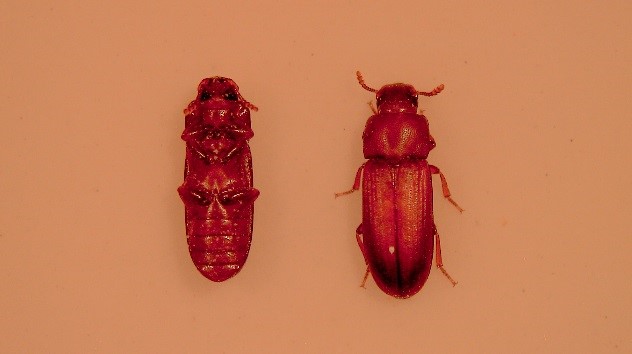Enlarge Image
Death feigning is controlled by dopamine in a beetle
Since Edmunds, much research has focused on the behavior adopted by animals to avoid attack by enemies.
However, there have been no analysis of gene expression associated with death feigning as an animal defense behavior.
Now, Takahisa Miyatake at Okayama University, Ken Sasaki at Tamagawa University, and Yajima Shunsuke at Tokyo University of Agriculture and their colleagues have compared the gene expression profiles of strains exhibiting different behaviors, that is differing durations of death feigning, in the beetle Tribolium castaneum. Beetles artificially selected for short and long durations of death feigning for many generations were compared thoroughly by RNA sequencing.
The researchers identified 518 differentially expressed genes (DEGs) between the strains. The strains also showed divergence in unexpected gene expression regions. As expected from previous physiological studies, genes associated with the metabolic pathways of tyrosine, a precursor of dopamine, were differentially expressed between the S and L strains; these enzyme-encoding genes were expressed at higher levels in the L strain than in the S strain.
Furthermore, it was also found that several genes associated with insulin signaling were expressed at higher levels in the S strain than in the L strain. Quantitative real-time PCR analysis showed that the relative expression levels of Tchpd (encoding 4-hydroxyphenylpyruvate dioxygenase, Hpd) and Tcnat (encoding N-acetyltransferase, Nat) were significantly higher in the L strain than in the S strain.
These results suggest the influence of these enzymes on the supply of dopamine and duration of death feigning.
Reference:
- Title of original paper: Transcriptomic comparison between beetle strains selected for short and long durations of death feigning
- Journal, volume, pages and year: Scientific Reports 9, 14001 (2019)
- Digital Object Identifier (DOI): doi:10.1038/s41598-019-50440-5
- Journal website: https://www.nature.com/articles/s41598-019-50440-5#Sec1
- Affiliations: Department of Graduate Sciences of Environmental and Life Sciences, Okayama University
- Affiliations: The Pheasant Memorial Laboratory, Institute for Planetary Materials, Okayama University
- Okayama University Scientific Achievement Repository:
http://ousar.lib.okayama-u.ac.jp/57359


